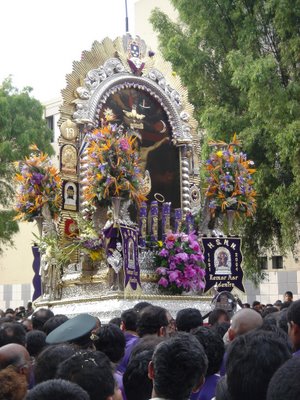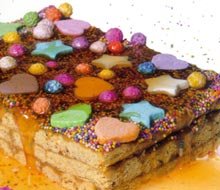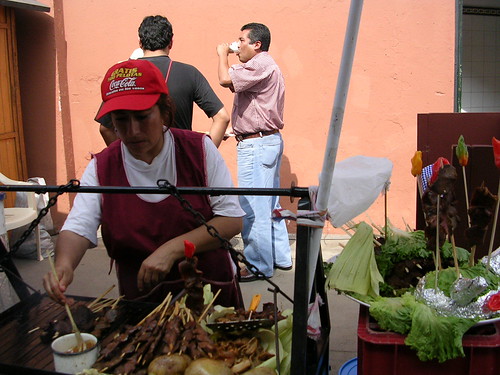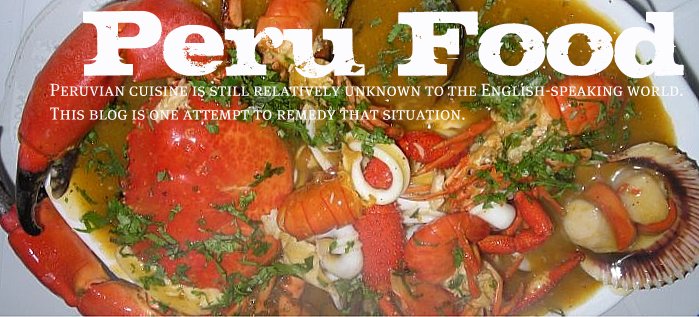 Photo: Los Hoffman Wing
Photo: Los Hoffman Wing
In Lima, October is known as el mes morado, the purple month. Why? Purple is the color worn by the faithful who follow the processions of the most venerated religious image in Peru: El Señor de los Milagros, the Lord of Miracles, a uniquely Peruvian image of Jesus Christ.
During October, in the colonial center of Lima, this image is taken from its home church, Las Nazarenas, in a series of processions to other historic colonial churches. The smell of incense, the steady beating of drums, and the footsteps of the faithful accompany these processions which wend their way along the narrow streets of colonial Lima as they have for hundreds of years.

Photo: Radio Programas del Peru
The origins of this image of Christ date back to 1651. According to religous belief, in that year, there was a group of African slaves from Angola living in the area known as Pachacamilla, where Las Nazarenas Church now stands. The slaves had been converted to Christianity and one of them, unnamed in the history books, painted an image of Christ on a wall of a building where the new converts converged to pray. The image struck a chord among the slaves, who began to bring offerings to leave before it. In 1655, an earthquake of such magnitude struck Lima that most of the city was destroyed. The building where this image of Christ was housed collapsed except for one wall: the wall where a few years earlier that Angolan slave had painted the image.
Photo: Peru 21
For 15 years, the wall with this image of Christ was abandoned to the elements. In 1670, a neighbor found the image and began to worship there. He rebuilt the shrine for the image and according to belief, as a result, the man was cured of life-threatening tumor. From that point on, the entire Pachacamilla district began to worship the image, believing it to be miraculous.
Photo: Radio Programas del Peru
Most of the faithful were descendants of those Africans brought as slaves to the plantations and haciendas of coastal Peru. One of the rituals that began during this period was that every Friday evening people would gather at the site of this image, bringing flowers, lighting candles, burning incense, and playing music on harps and with the traditional Peruvian cajón.

Photo: Radio Programas del Peru
Within time, these celebrations reached the ears of Church leaders in the Archbishop's Palace, where they were seen as a threat to the established order. The Viceroy himself ordered the image painted over in 1671. The legend of El Señor de los Milagros continues: an Indian man was brought under guard to the site where the image was being venerated in order to paint it over. As he approached the image, brush in hand, the man began to tremble and shake. He was unable to carry out the order. Another painter was brought in, this one a soldier, and he too was unable to paint it over. The more the authorities tried to paint over the image, the more the local people protested. Finally, the Viceroy revoked the order and ordered a proper chapel built on the site.
Photo: Radio Programas del Peru
Since that time, the image became a focal point for popular veneration. In 1687, another earthquake struck Lima, once again destroying much of the colonial center, including the chapel that had been built to house the image. Once again, the one wall with the image remained standing while the other ones collapsed. Popular fervor led church leaders to order a painting of the image, which was taken out in a procession for the first time the 18th, 19th, and 28th of October, 1687. Since that year, the image has been taken out of its home church in a series of processions to other colonial churches during those dates.
Photo: Radio Programas del Peru
El Señor de los Milagros was named the patron of Lima in 1715. That was also the first year the image was given the title by which it is known today: El Señor de los Milagros de Nazarenas.
So, what does this have to do with food? Well, as to be expected, there are special foods associated with such an important religious occasion. Three of the most traditional Peruvian foods eaten at this time are turrón, anticuchos, and picarones.

Turrón de Doña Pepa
Photo: De Pan y Todo
No one really knows the origin of the sweet layered pastry popularly called turrón de Doña Pepa. Legend has it that was invented by the lady in a wealthy Lima family, although others claim that its origins are with a cook of African descent known as 'ña Pepa. What is known about this unique style of turrón (since there is a similarly named dish in other Spanish-speaking countries, although all are different from one another) is that it has long been associated with the celebrations in honor of El Señor de los Milagros, when this sweet is consumed with almost religious devotion.

Anticuchos on the grill.
Photo: Traveling Man
Anticuchos, grilled meat on a skewer, are another popular food during the month of October. According to researchers, the name comes from the Quechua word antikucho, meaning 'Andean cut' or 'Andean mix'. Prior to the arrival of the Spanish, these types of brochettes were made with llama or other local meats. In the 1500s, the Spanish began preparing something similar to the modern day anticucho, substituting beef for llama.
Once again the influence of Africans resonates in Peruvian culinary and cultural history.
The Spanish would give their African slaves the parts of the cow they wouldn't eat themselves. This included the beef heart. The slaves took the beef heart and seasoned it heavily prior to marinating it and then grilling it in imitation of their masters. Over time, the beef heart anticuchos would become the Peruvian favorite. They are still one of the most popular street foods available in Peru, and during El Señor de los Milagros, anticucho sellers set up grills in the late afternoon, tempting passersby with the aromatic smells of seasoned grilled meats.

Picarones with syrup.
Photo: Radio Programas del Peru
Finally, picarones are pumpkin fritters that are also eaten as late-afternoon street food during El Señor de los Milagros celebrations. This is another dish that has its origins in the colonial period. Some believe they are a local adaptation of Spanish buñuelos. Picarones are made of squash or pumpkin dough and sweetened with chancaca, raw cane sugar melted into a syrup. I have a post about picarones which includes a recipe for this tasty dessert.
being taken out of Las Nazarenas Church.
During el mes morado, the purple month, Peruvians demonstrate their loyalty not only to their religious beliefs but also to their culinary traditions.
Peru.Food@gmail.com
.
.
.
TAGS: Peru, Peruvian, food, cooking, cuisine, cocina, comida, gastronomía, peruana





3 comments:
AH, I was hoping to see this post! I spent the whole day yesterday at the precession here in NYC and it was cold. Took a lot of beautiful photos and video. I'll post on this on the 18th. By the way, how can I post a video to the blog? Take care, and keep injoying the turron y picarones! Que rico, ya me dio ambre.
Luis
Sher: Thanks for stopping by!
Luis: I'm glad you liked the post. I can't wait to see the pictures from NYC.
Saludos!
I'M GLAD THIS WAS POSTED HERE. WHEN MY FMILY AND I WERE AT THE PRECESSION HERE IN CHICAGO LAST OCTOBER I HAD MANY OF MY [NON PERUVIAN] FRIENDS ASK A LOT OF QUESTIONS ABOUT THE CUSTOMS AND THE ACTUAL PRECESSION...NOW THEY'RE ALL HUNGER FOR PICARONES!! THANKS FOR THE POST AGAIN. TAKE CARE -N.VIDAL
Post a Comment